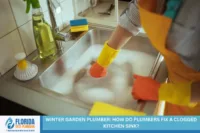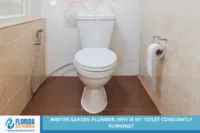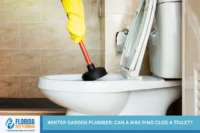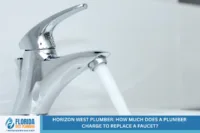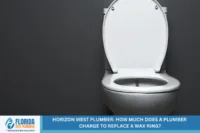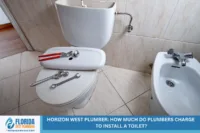In Horizon West, FL, a plumber is essential for maintaining the proper function of your home’s plumbing system, especially when it comes to your toilet. Over time, wear and tear can affect the performance of your toilet, leading to common issues such as frequent clogs, leaks, and inefficiency. These problems can disrupt your daily routine and increase your water bill. Understanding when it’s time to call a plumber to replace your toilet is crucial for preventing further damage and ensuring a smoothly running home.
In this blog, we will explore the key signs that indicate your toilet may need to be replaced and why addressing these issues promptly is essential. By the end, you’ll know exactly when to contact a professional plumber in Horizon West, FL, to avoid further plumbing problems.
Signs That Indicate You Need a Plumber for Toilet Replacement in Horizon West, FL
Toilets, like any other plumbing fixture, don’t last forever. While regular maintenance can extend their life, there will come a time when replacement is necessary. These are some of the most common signs that indicate it’s time to call a plumber to replace your toilet in Horizon West, FL:
1. Frequent and Unmanageable Clogs
A toilet that frequently clogs, no matter how often you attempt to clear it, is a common indication that something is wrong. Over time, the flushing system in older toilets can become less effective. The internal components, such as the flush valve and trapway, may wear out, causing the toilet to struggle with waste removal. A professional plumber can evaluate the situation and determine if the toilet should be replaced. If you find yourself constantly dealing with clogs, it’s better to replace the toilet to avoid ongoing frustration.
2. Cracks or Visible Damage to the Toilet Bowl or Tank
A cracked toilet is more than just an aesthetic concern—it can lead to serious plumbing issues. Even small cracks can cause water leakage, which over time can damage the floor beneath and lead to water waste. Visible damage, such as cracks or chips in the porcelain, may also indicate that the toilet’s integrity has been compromised. A professional plumber should inspect any cracks or damage to determine whether replacement is necessary. If the cracks are located in high-pressure areas of the toilet, such as the tank, it can eventually lead to a complete breakdown of the toilet.
3. A Constantly Running Toilet
A running toilet wastes water and increases your utility bill. While minor adjustments or fixes, such as replacing the flapper valve or adjusting the float, might solve the problem temporarily, if your toilet continues to run despite these fixes, it may be an indication that the internal components are beyond repair. The longer a toilet runs, the more water it wastes. A plumber can help determine if the internal parts need to be replaced or if the entire toilet needs to be replaced due to age and wear.
4. Continuous Need for Repairs
If you find yourself calling a plumber frequently for repairs, it could be more cost-effective to replace the toilet rather than continuing to repair it. Repeated repairs, whether related to the flushing mechanism, leaks, or other components, suggest that the toilet’s parts are degrading, and replacing it will likely save you money in the long run. Frequent repairs often indicate a systemic issue with the toilet’s structure or mechanics, making replacement a better option for the long-term health of your plumbing system.
5. Inefficient Flushing or Weak Flushes
A toilet’s primary function is to flush waste effectively. If your toilet has started leaving debris behind or requires multiple flushes to clear the bowl fully, it may indicate that the flushing system is worn out. Older toilets may no longer produce the necessary pressure to clear the bowl with a single flush, potentially leading to sanitation issues. Weak flushes are often a sign of damaged internal components, or the toilet may be too outdated to function properly. In such cases, it’s best to call a plumber to replace the toilet with a more efficient model.
6. Water Leaks Around the Base of the Toilet
Leaks around the base of the toilet are not only a nuisance but also a serious issue that can lead to water damage, mold growth, and an increased risk of slip and fall accidents. The most common cause of these leaks is a worn-out wax ring seal between the toilet and the floor. While this can sometimes be repaired, in many cases, the issue is a symptom of more severe structural damage or aging. If a toilet is leaking around the base, it’s important to consult a plumber to assess whether a full replacement is necessary.
7. Rising Water Bills
A toilet that uses more water than it should is contributing to higher water bills. Older models often use a significant amount of water per flush, whereas newer, more efficient toilets are designed to use less water. If your water bills are consistently high and you suspect your toilet is to blame, replacing it with a modern, water-efficient model could be a great way to reduce both your utility costs and your environmental footprint. Many of the newer toilets on the market today feature water-saving technology that uses much less water per flush than older models.
Why Replacing Your Toilet Is So Important
Leaving a toilet that’s showing signs of damage or inefficiency can have negative consequences. These consequences may range from increasing water bills to severe water damage that could require expensive repairs to your floors or plumbing system.
By replacing an old or malfunctioning toilet promptly, you avoid ongoing repair costs and water wastage. A new toilet can save you money on water bills, reduce the risk of water damage, and ensure that your plumbing system is functioning as efficiently as possible. Investing in a new toilet may seem like a significant expense, but it offers long-term savings and peace of mind.
Why You Should Choose a Professional Plumber for Toilet Replacement
To ensure a smooth and stress-free toilet replacement, it’s vital to hire a professional plumber. Attempting to replace the toilet yourself without the proper knowledge and tools can lead to errors that could worsen the problem or cause further damage to your plumbing system. Hiring a professional plumber ensures that the job is done correctly, with all necessary inspections and adjustments made to guarantee that your new toilet functions properly.
Take Action Before Small Problems Turn Into Big Issues
Ignoring the signs that it’s time to replace your toilet can lead to unnecessary stress and future additional costs. By being proactive and addressing issues such as frequent clogs, leaks, or inefficient flushing early, you can avoid further complications and maintain the comfort and functionality of your home’s plumbing system. Always remember that replacing an old or inefficient toilet with a new one is not just about aesthetics—it’s about improving your home’s overall plumbing efficiency and reducing the risk of costly repairs.
If your toilet is showing any of these warning signs, it’s time to call a plumber in Horizon West, FL, who can assess the situation and determine whether replacement is the best course of action. Don’t wait until small issues become big problems—contact a plumber today to keep your home’s plumbing in top condition and avoid more expensive repairs down the road.
Horizon West Plumber – Florida Best Plumbing
Florida Best Plumbing LLC is here to be your trusted plumber for all your plumbing needs in Horizon West, FL. We specialize in a wide range of plumbing services, including toilet repairs and replacements, as well as comprehensive system installations and replacements. Our team is dedicated to providing reliable and affordable plumbing solutions, ensuring that your plumbing system operates smoothly at all times.
Whether you need a simple toilet replacement or more extensive plumbing work, we are your go-to solution for all your plumbing needs. Call us today at (407) 683-6644 to schedule your service!
FAQ: Common Questions About Toilet Replacements and Plumbing in Horizon West, FL
1. What Causes Frequent Clogs in My Toilet?
Frequent clogs are often a result of poor flushing efficiency or underlying plumbing issues. Toilets that struggle to clear waste typically have an inefficient flush volume, making them more prone to blockages. There are several reasons for persistent clogs:
- Low-flush toilets: Older, water-efficient toilets may not have sufficient force to clear waste in a single flush.
- Mineral deposits or mineral buildup: Hard water can leave mineral deposits in the drain holes, blocking the water flow and reducing flushing power.
- Clogged overflow tube or drain hole: This restricts water flow, causing incomplete flushing.
- Toilet tank issues: A malfunctioning fill valve or flapper valve may prevent the toilet tank from filling properly, resulting in reduced flush pressure.
Replacing your toilet with a high-efficiency model can help reduce clogs, especially modern siphon jet toilets, which provide a powerful flush without excessive water use. It’s essential to maintain regular toilet repair and plumbing inspections to avoid plumbing disasters.
2. Why Does My Toilet Keep Running After I Flush?
A toilet that continues to run after flushing is usually caused by faulty internal components. The most common culprits are:
- Flapper valve failure: If the rubber flapper in the toilet tank doesn’t seal properly, water continues to flow, resulting in a constant running toilet.
- Worn-out fill valve: A malfunctioning fill valve can cause the water to keep flowing into the tank without stopping.
- Hairline cracks in the tank: Occasionally, small cracks in the toilet tank can allow water to escape, resulting in a constant need to refill the tank.
In this case, it’s advisable to have a plumber inspect and replace the flapper valve or toilet handle. If your toilet is older and prone to such issues, upgrading to a high-efficiency toilet or a dual-flush toilet might offer better water-saving benefits and improved functionality.
3. How Do Mineral Deposits Affect My Toilet?
Mineral deposits, also known as mineral buildup, are common in areas with hard water. Over time, these deposits accumulate on various parts of the toilet, leading to several issues:
- White buildup around the rim holes and flush holes: This is caused by calcium and lime buildup, which obstructs water flow.
- Blockages: The accumulation of mineral deposits in pipes and toilet drains can cause clogs or restrict water flow, reducing flush efficiency.
- Damage to the porcelain throne: Prolonged exposure to minerals can weaken the toilet’s structure, leading to cracks or surface degradation.
To prevent mineral buildup, consider using a water softener to reduce the hardness of the water and prevent mineral deposits from forming. Regular toilet repair and maintenance can help address and remove the buildup, ensuring your toilet continues to function properly.
4. What Should I Do If My Toilet Has a Cracked or Wobbly Base?
A wobbly toilet or cracked bowl can be a sign of serious damage to the toilet’s foundation. It’s crucial to address these issues as soon as possible to prevent further damage or water leaks. Causes of a cracked or wobbly toilet include:
- Subfloor deterioration: When the subfloor beneath the toilet weakens due to moisture, the toilet can shift, causing instability and potential cracks.
- Improper installation: A poorly installed toilet may not be secured tightly, causing it to wobble or shift.
- Cracked bowl: Even small hairline cracks in the porcelain can compromise the toilet’s structural integrity.
If you notice a wobbly toilet, it’s important to call a plumber immediately. They can assess the situation and either tighten the toilet bolts or recommend replacing the toilet if it’s too damaged. In some cases, a wall-hung toilet or elongated toilet may be a better option for added stability.
5. What Are the Benefits of Installing a Water-Efficient Toilet?
Switching to a water-efficient toilet offers several key advantages, both for your home and the environment:
- Lower water bills: Modern toilets, such as high-efficiency toilets and dual-flush toilets, use significantly less water per flush than older models, resulting in lower monthly water bills.
- Improved water efficiency: These toilets typically use 1.28 gallons per flush or less, compared to older toilets that can use up to 3-5 gallons per flush, reducing overall water consumption.
- Environmentally friendly: Water-saving benefits contribute to sustainability by conserving precious water resources.
- Enhanced performance: New models often utilize advanced flush technology, such as pressure-assist toilets, which provide a powerful flush while minimizing water waste.
Replacing your outdated toilet with a modern water-efficient model not only benefits your home but also helps conserve water for future generations.
Read more: When to Call a Plumber in Horizon West, Florida for Toilet Repairs vs. Replacement
Winter Garden Plumber: How Do Plumbers Fix a Clogged Kitchen Sink?
If you need a plumber in Winter [...]
Winter Garden Plumber: Why is My Toilet Constantly Running?
Is your first instinct to call a [...]
Winter Garden Plumber: Can a Wax Ring Clog a Toilet?
If you’ve ever dealt with a clogged [...]
Horizon West Plumber: How Much Does a Plumber Charge to Replace a Faucet?
Are you frustrated by leaky faucets, a [...]
Horizon West Plumber: How Much Does a Plumber Charge to Replace a Wax Ring?
If you’ve ever noticed water pooling around [...]
Horizon West Plumber: How Much Do Plumbers Charge to Install a Toilet?
Are you feeling overwhelmed trying to find [...]


